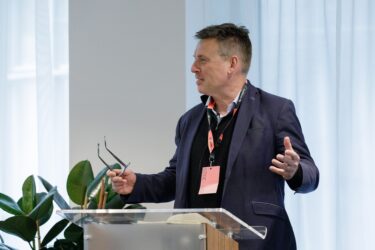
This blog was written by Anthesis CEO, Stuart McLachlan and is part 3 of a series of insights on this years’ Conference of the Parties 28 (COP28) in the United Arab Emirates.
My discovery at COP28 of the Inner Development Goals (a project to map and encourage the behaviours we need for the sustainability transition) has got me thinking about collaboration. It’s one of the big themes of the IDGs, which is reassuring as we’ve been saying that collaboration is critical to unlock the value in sustainability and to get organisations moving in the right direction for as long as I can remember. I’m always a bit worried by buzzwords on walls or screens and this year at COP, the collaboration word was everywhere – positioned as some sort of a behavioural silver bullet and perhaps a rebuke to the many competing factions looking for territorial advantage in the Blue Zone.
But overuse of the word doesn’t make it any less important – something I’m particularly sensitised to at the moment as Anthesis goes through another round of growth. We preach collaboration internally and with our clients but what does it look like? If we can surface the difference it makes in more practical terms perhaps it becomes easier to apply it at scale. So, here’s an attempt to illustrate how collaboration is central to delivering the transition that’s on everyone’s mind in Dubai…
1. Operating in Total Value Systems
Few organisations get this at the moment. They work in old era systems where they perceive suppliers and customers to be outside the corporate stronghold, and they use buyer leverage over supplier leverage to maximise economic value in the corporate storehouse with most of the value being channelled to the shareholders.
Enlightened companies think of themselves as part of a total value system: a business ecosystem where they must connect with all stakeholders in different ways. Thriving in such a system is made possible by digital solutions bringing clarity to the complexity, driven by enlightened leadership and delivered through a spirit of collaboration. This is the inevitable direction of travel for companies and economies as the quest for sustainable performance drives us towards new models of stakeholder capitalism.
Collaboration will be the necessary enabler of success in the context of new accounting and reporting norms that force action on Scope 3 emissions or transparency in supply chains. We see it first hand at Anthesis when we convene the players in a value chain for the first time and enable new conversations.
2. Compliance in pre-competitive spaces
Anthesis has been working on precompetitive collaboration in the chemical sector for a decade, running coalition processes for chemical companies who all pay an amount into a vehicle that seeks to solve a shared, industry-wide problem. Most of this work is done to help clients meet the requirements of the REACH Regs and to explore opportunities for hazardous chemicals substitution strategies. However, as ESG and sustainability regulation becomes more prevalent in our markets we believe similar models will be required in many sectors, for example apparel and healthcare. As regulation levels the playing field and pre-competitive spaces open up, this form of cross-sector collaboration will become a vital part of compliance and performance.
3. Burning Platforms
Possibly the most powerful example of the power of collaboration comes from research Dean Sanders and I did in the writing of ‘The Adventure of Sustainable Performance’. It’s an example of what happens when Purpose and Collaboration combine. We interviewed Adam Blomerley, CEO of a Company that was part of a consortium which included Mclaren F1, Ford and Airbus. These unlikely Collaboration partners came together in response to a challenge for hospital grade ventilators to be manufactured at the start of the pandemic.
As Adam put it, “hundreds of people put their hands up and said, ‘Yeah, we can do it’ – from people in their sheds to large global manufacturers. It took around 100 days to go through design, test, certification and then build 12000 of them. For the people involved, it was a compelling and emotional journey to be on. It was about the art of the possible, rather than focusing on what we could not do. We knew that every day 1000 people were dying and that was a strong motivating force.”
These are just three examples of what collaboration can deliver when it’s seen as a practical enabler – and when we activate it to bring surprising solutions to critical problems. I hope the many delegates who read or indeed use the word in Dubai can make it a powerful reality, an enabler, in the months and years ahead.
We are the world’s leading purpose driven, digitally enabled, science-based activator. And always welcome inquiries and partnerships to drive positive change together.




